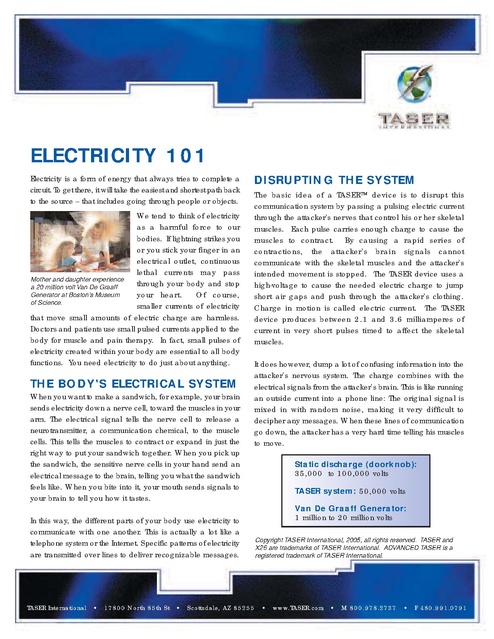Electricity 101, Taser Intl, 2005
Download original document:

Document text

Document text
This text is machine-read, and may contain errors. Check the original document to verify accuracy.
ELECTRICITY 101 Electricity is a form of energy that always tries to complete a circuit. To get there, it will take the easiest and shortest path back to the source – that includes going through people or objects. We tend to think of electricity as a harmful force to our bodies. If lightning strikes you or you stick your finger in an electrical outlet, continuous lethal currents may pass Mother and daughter experience through your body and stop a 20 million volt Van De Graaff Generator at Boston’s Museum your heart. Of course, of Science. smaller currents of electricity that move small amounts of electric charge are harmless. Doctors and patients use small pulsed currents applied to the body for muscle and pain therapy. In fact, small pulses of electricity created within your body are essential to all body functions. You need electricity to do just about anything. THE BODY'S ELECTRICAL SYSTEM When you want to make a sandwich, for example, your brain sends electricity down a nerve cell, toward the muscles in your arm. The electrical signal tells the nerve cell to release a neurotransmitter, a communication chemical, to the muscle cells. This tells the muscles to contract or expand in just the right way to put your sandwich together. When you pick up the sandwich, the sensitive nerve cells in your hand send an electrical message to the brain, telling you what the sandwich feels like. When you bite into it, your mouth sends signals to your brain to tell you how it tastes. DISRUPTING THE SYSTEM The basic idea of a TASER™ device is to disrupt this communication system by passing a pulsing electric current through the attacker’s nerves that control his or her skeletal muscles. Each pulse carries enough charge to cause the muscles to contract. By causing a rapid series of contractions, the attacker’s brain signals cannot communicate with the skeletal muscles and the attacker’s intended movement is stopped. The TASER device uses a high-voltage to cause the needed electric charge to jump short air gaps and push through the attacker’s clothing. Charge in motion is called electric current. The TASER device produces between 2.1 and 3.6 milliamperes of current in very short pulses timed to affect the skeletal muscles. It does however, dump a lot of confusing information into the attacker's nervous system. The charge combines with the electrical signals from the attacker's brain. This is like running an outside current into a phone line: The original signal is mixed in with random noise, making it very difficult to decipher any messages. When these lines of communication go down, the attacker has a very hard time telling his muscles to move. In this way, the different parts of your body use electricity to communicate with one another. This is actually a lot like a telephone system or the Internet. Specific patterns of electricity are transmitted over lines to deliver recognizable messages. TASER International • 17800 North 85th St • Scottsdale, AZ 85255 Static discharge (doorknob): 35,000 to 100,000 volts TASER system: 50,000 volts Van De Graaff Generator: 1 million to 20 million volts Copyright TASER International, 2005, all rights reserved. TASER and X26 are trademarks of TASER International. ADVANCED TASER is a registered trademark of TASER International. • www.TASER.com • M 800.978.2737 • F 480.991.0791





